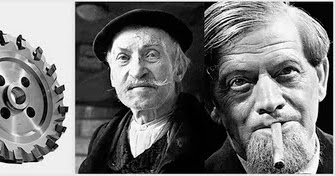Joel Meyerowitz speaks of his first days as a street photographer, when he worked with Robert Frank 50 years ago
Link: “The photographer was a guy named Robert Frank” – British Journal of Photography
Joel Meyerowitz speaks of his first days as a street photographer, when he worked with Robert Frank 50 years ago
Link: “The photographer was a guy named Robert Frank” – British Journal of Photography

Mid-century Motor City images from Robert Frank’s iconic American road trip
A couple years ago I had heard rumored that the eccentric Japanese publisher Kazuhiko Motomura was working on a special “book” on Robert F…
Link: http://5b4.blogspot.com/2010/03/robert-frank-81-contact-sheets.html
A couple years ago I had heard rumored that the eccentric Japanese publisher Kazuhiko Motomura was working on a special “book” on Robert Frank’s contact sheets from The Americans. That rumor had quieted a bit after Sarah Greenough’s masterwork Looking In seemed to beat it to the punch by reproducing every sheet that had an image that appeared in Frank’s final published edit, but Motomura proceeded anyway and Robert Frank: 81 Contact Sheets from The Americans is out. I have seen it and I have to say it is pretty amazing.

The five-exposure contact strip of 35-millimeter Kodak Plus-X film begins unremarkably enough. But don’t miss Frame 16. And don’t miss this show.
via Lens Blog: http://lens.blogs.nytimes.com/2009/12/30/must-32/
The five-exposure contact strip of 35-millimeter Kodak Plus-X film begins unremarkably enough. Frame 12: Helmeted policemen gather around a motorcycle. Frame 13: Pedestrians move one way or the other on the sidewalk. (Not bad. Some promise there.) Frame 14: A woman and children gaze up at something above them. Frame 15: Well-dressed shoppers appear to be peering into a store window.
And then, suddenly, there’s Frame 16.

Before arriving to New York, Robert Frank prepared a portfolio of 40 photographs in order to introduce his work to magazine editors. Upon …
Link: http://5b4.blogspot.com/2009/12/portfolio-40-photos-19411946-by-robert.html
Before arriving to New York, Robert Frank prepared a portfolio of 40 photographs in order to introduce his work to magazine editors
A detailed exhibition currently at the New York Met reveals the extraordinary power of the photographer’s eye, finds Sean O’Hagan
via the Guardian: http://www.guardian.co.uk/artanddesign/2009/nov/30/robert-frank-the-americans-exhibition
First published in France in 1958 and – to considerable controversy – in America the following year, The Americans remains one of the most important photography books of the 20th century. “It is difficult to remember how shocking Robert Frank’s book was,” the late, great John Szarkowski wrote in 1968, having curated an earlier show of the work at New York’s Museum of Modern Art. “The pictures took us by ambush then … He established a new iconography for contemporary America, comprised of bits of bus depots, lunch counters, strip developments, empty spaces, cars, and unknowable faces.”

photo by David Burnett
From We’re Just Sayin: Frank at the National:
We photographers all wish we could get someone to just pay us to wander and shoot great pictures.

In a sense, Looking In: Robert Frank’s The Americans is another expression of the status of the work. If you want to find out about its photographer and history (and a lot of other things) this is where you want to look.

The Americans showed a different America than the wholesome, nonconfrontational photo essays offered in some popular magazines. Robert Frank’s subjects weren’t necessarily living the American dream of the 1950s: They were factory workers in Detroit, transvestites in New York, black passengers on a segregated trolley in New Orleans. Frank didn’t even get much support from the art world, he recalls.
“The Museum of Modern Art wouldn’t even sell the book,” Frank says. “But the younger people caught on.”

Today, May 15th, is the 50th anniversary of the day Robert Frank’s The Americans was first published by Robert Delpire in Paris. That was 1958. Today we realize that The Americans has more in common with beat poetry and club jazz than it has with many other kinds of photography; it’s one of the high water marks of 1950s culture. And throughout an era when photographers communicated with each other and with their audiences mainly through the vehicle of published books, The Americans has had only a handful of competitors (Walker Evans’ American Photographs, Henri Cartier-Bresson’s The Decisive Moment, a few others) for the title of the most important single photography book ever published. For thirty years after its publication it was deeply influential. And although photography has moved on now, the echoes of its impact reverberate still.
Check it out here.

Digital photography destroys memory, he believes, with its ability to erase. Art school is another problem, teaching students to be blind. Editors are worse—they poke the artist’s eyes out. Photography: one minute it’s not art at all. Then perhaps it is. And then again it is not. That’s Robert Frank.
“There are too many images,” he said. “Too many cameras now. We’re all being watched. It gets sillier and sillier. As if all action is meaningful. Nothing is really all that special. It’s just life. If all moments are recorded, then nothing is beautiful and maybe photography isn’t an art anymore. Maybe it never was.”
Check it out here.
It is rare for a photographer that came of age in the 1960’s and 70’s to not cite Robert Frank’s The Americans and Walker Evans’ American Photographs as the two books that inspired them to take up a camera and explore the world. It is lore that gets repeated so often it almost seems disingenuous in the retelling. I have often thought that it isn’t possible that so many people could be so instantly enamored since, as much as it may be embarrassing to admit, both of those books took a while for me to warm up to them and see their true greatness. I’ve come around, probably in the same way that an early critic of the first edition of The Americans had when he described Frank as one who “produced pictures that look as if a kid had taken them while eating a Popsicle and then had them developed and printed at the corner drugstore.” That critic failed to specify which flavor of Popsicle would have fueled such a remarkable feat. If he had, maybe photographers would have flocked to have given it a taste.
Check it out here.